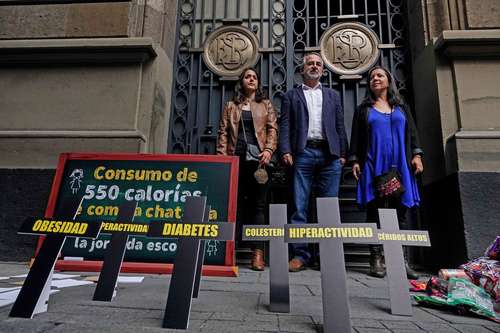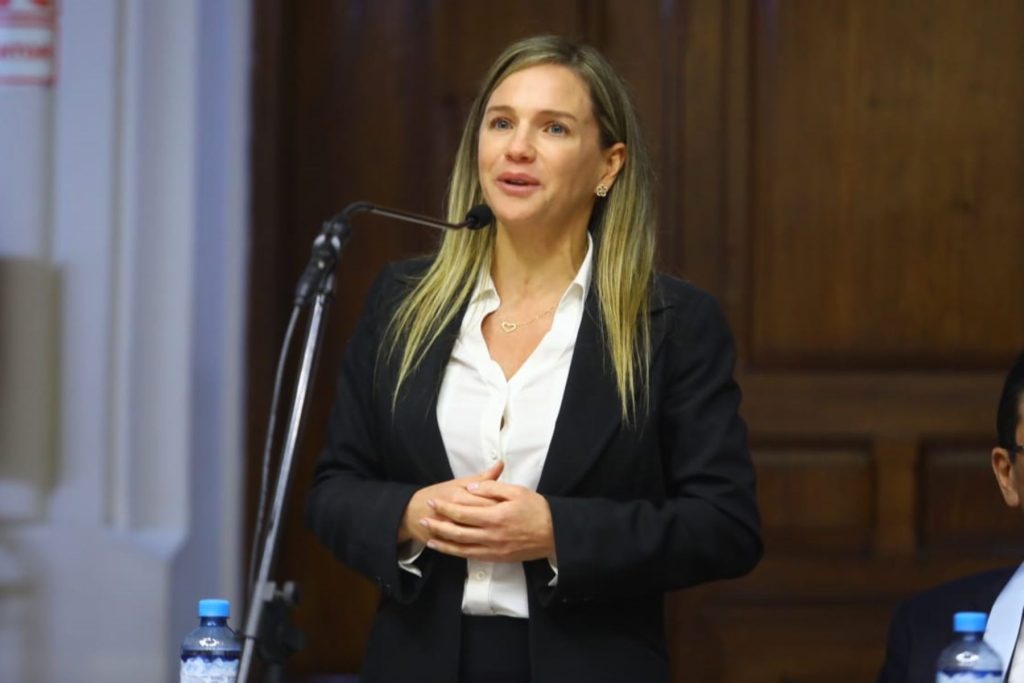▲ Members of the civil association El Poder del Consumidor have held protests to denounce the amount of ultra-processed foods sold in schools.Darkroom Photo
Alexia Villaseñor and Laura Poy
La Jornada Newspaper
Monday, January 6, 2025, p. 4
Mexico is among the most lagging countries in Latin America and the Caribbean in the coverage of school feeding programs, since in the region the average coverage ranges between 30 and 40 percent of its enrollment, but in our country little is served. more than 6 million schoolchildren with breakfast and lunch, that is, above 18 percent, stated Liliana Bahena, coordinator of the My Healthy School campaign, from El Poder del Consumidor.
Guaranteeing nutritious and balanced food for the school population has not been easy, not only because of the resistance of the ultra-processed products industry, but also because the bad eating habits that prevail in most homes, and that in many cases are reflected in the epidemic of obesity and overweight among girls, boys and adolescents
he explained.
Specialists, teachers and parents added that despite the school breakfast and hot food programs in full-time schools, We are far from a true universal and free school feeding program
despite the fact that it is one of the public policies with the greatest return.
The United Nations Educational, Scientific and Cultural Organization (UNESCO) estimates that for every dollar invested in food for the school population, a return of nine dollars is achieved in long-term benefits in health and well-being.
Overweight, obesity and micronutrient deficiency
The National Health and Nutrition Survey (Ensanut) Continuous 2023 warns that in Mexico 34.2 percent of the school population from five to 11 years old suffers from overweight and obesity, while in adolescents from 12 to 19 years old it reaches 38.1 percent.
Added to this is a deficiency of micronutrients such as vitamin B12 and D. In the case of children between five and 11 years old, it is 22.9 and 30.3 percent, respectively, while 40 percent of young people report vitamin B12 deficiencies, and 43.8 percent, vitamin D.
Francisco Bravo, director of the Leonardo Bravo primary school, located in the Cuauhtémoc mayor’s office, in Mexico City, whose campus serves hot food for 240 children, and 100 more, of the rest of its enrollment, bring their own food, explains : Many parents and students know that they should eat nutritious foods, but it is difficult for us to do so, because the eating habits of families, in general, are not the healthiest. It is difficult for them to learn to eat fruits, vegetables and drink plain water
.
At school, he stated, we have worked in two spheres: instilling healthy eating in children, but also in parents, because we know that if you do not have an impact on the family, you will not achieve the transformation you seek
.
Ultra-processed industry, barrier
On a tour taken by The Day to various supermarkets in Mexico City, it was found that the majority of families who come with young children or adolescents include in their basic basket products with high calorie content and sugary drinks, which are mostly requested by the children and adolescents themselves. , especially sweets and snacks.
In this regard, Liliana Bahena highlighted that this is largely due to effective advertising that It continually bombards children and adolescents to promote the consumption of ultra-processed products.
.
As part of the strategies, he indicated, not only is Internet advertising used – poorly regulated – but also sales strategies such as placing sweets, sweets and sugary drinks. right at children’s height, so that these products catch their attention
.
In this regard, Ensanut Continua 2023 highlights that the consumption of unhealthy foods in the school population is high. In the case of children from five to 11 years old, an intake of 86.1 percent is reported for sweetened beverages, and 55.9 percent for snacks, sweets, desserts and sugary cereals.
In the case of adolescents from 12 to 19 years old, the intake of high-calorie beverages was 90.6 percent; and in the case of snacks and sweets, it is 55.9 percent, while 39.1 percent consume sugary cereals.
In contrast, the consumption of fruits and vegetables is low. For students ages five to 11, it is 51.3 percent for fruits, and 28.4 percent for vegetables. In adolescents, only 38 percent consume fruit; 29.7 percent vegetables, and 16.7 percent legumes.
Another risk factor, specialists warn, is low physical activity among children and adolescents. The Ministry of Health (Ssa), through Ensanut Continua 2023, warned that only 32.6 percent of schoolchildren aged 10 to 14 managed to accumulate an average of 60 minutes of physical activity of moderate to vigorous intensity, at least four days. per week.
In this regard, it was detected that 73.4 percent of adolescents spend more than two hours a day in front of the screen. In the case of young people between 15 and 19 years old, 49.9 percent meet the World Health Organization’s recommendation of doing 60 minutes of physical activity a day.
Food and school cafeterias
Gloria del Castillo, director of the Latin American Faculty of Social Sciences (Flacso), highlighted that the installation of school cafeterias, which according to data from the Ministry of Public Education (SEP), were created in the 2017-2018 cycle in 13 thousand 638 schools throughout the country, benefiting 1.6 million students, It has generated greater well-being for students, since it allows them a better condition to be able to study.
.
He added that investigations reveal that It is not just about feeding children for the sake of eating, but about generating habits, giving a structure to girls, boys and adolescents.
on how to have a healthy diet.
He considered that it is very important that parents also get involved in these processes and that Be very aware of healthier eating regimens, in order to prevent overweight and obesity
. Hence, he considered, the importance of maintaining school cafeterias.
However, parents admit the complexity of the process to guarantee healthy food. In the rules to operate the food service in the La Escuela es Nuestra program, it is suggested that the cost of food per student be 15 pesos and the monthly support for the School Food Service Coordinator (CESA) be 3,800 pesos per month, which is totally insufficient
.
In many schools, the cost of each hot meal offered is at least 32 pesos, which includes a soup, a stew, and a fruit for dessert.
A school cafeteria manager pointed out that At first it was attempted to have the mothers be in charge of the dining room service, but it was very complicated, they were not always able to and there were complaints about the quantity and quality of the food. For that reason, they hired me, and now we offer a varied menu respecting the good eating dish that we propose every week, and it is approved by the director
.
A 2022 study from the World Food Program and the Inter-American Development Bank emphasizes that school feeding programs They play a fundamental role in motivating boys and girls to go to school. Once in the classroom, school meals ensure they are well fed and prepared to learn
. State investment, he emphasizes, is key to advancing the universal application of these programs, which in Latin America and the Caribbean benefit more than 80 million girls, boys and adolescents.
















